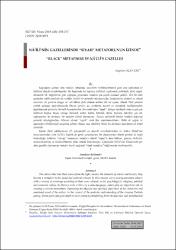Nâ’ilî’nin Gazellerinde “Siyah” Metaforunun İzinde
Abstract
Kaynağını ışıktan alan renkler, tabiattaki unsurları renklendirmenin yanı sıra toplumsal ve kültürel alanda metaforlaşırlar. Bu bağlamda her toplum; kültürel, toplumsal, psikolojik, dinî, siyasî, ekonomik vb. değerlerine göre çağrışım yönünden renklere çok çeşitli manalar yükler. Üst bir dille yaratılan edebî eserlerde ise renkler, belirli bir atmosfer oluşturmada, karakterlerin fiziksel ve ruhsal tasvirleri ile yazarın duygu ve ruh hâlini ifade etmede mühim bir rol oynar. Klasik Türk şiirinin estetik anlayışı doğrultusunda Divan şairleri de, renklerin tasvirî ve metaforik özelliklerinden faydalanarak şiirlerine derinlik kazandırırlar. Bu renklerden “siyah”, dünya mitolojilerinde ve pek çok kültürde boşluk, büyü, ıstırap, karanlık, keder, korku, kötülük, ölüm, üzüntü, tahribat, yas vb. çağrışımları ile olumsuz bir metafor olarak tanımlanır. Esasen tabiattaki bütün renkleri soğurup yutarak oluştuğundan, bilimsel olarak “siyah” renk bile sayılmamaktadır. Belki de ışığın ve aydınlığın örtülmesiyle meydana gelmiş olması, ona atfedilen bütün bu olumsuz manaların en temel sebebidir. Klasik Türk edebiyatının 17. yüzyıldaki en önemli temsilcilerinden ve Sebk-i Hindî’nin kurucularından olan Nâ’ilî-i Kadîm de gerek yaratılışının bir dışavurumu olarak gerekse de bağlı bulunduğu üslûbun “ıstırap” temasının metaforu olarak “siyah”ı; kara bahtını, gamını, kederini, mutsuzluklarını ve ümitsizliklerini ifade etmede kullanmıştır. Çalışmada Nâ’ilî’nin Divan’ında yer alan gazeller, kavramsal metafor teorisi ışığında “siyah metaforu” bağlamında incelenecektir. The colours that take their source from the light, encolor the elements of nature and besides, they become a metaphor in the social and cultural context. In this context, every society associates colours with a variety of meanings according to their own cultural, social, psychological, religious, political and economic values. In literary texts written by a meta-language, colors play an important role in creating a certain atmosphere, expressing the physical and spiritual depictions of the characters and emotional mood of the author. In the context of the aesthetic understanding of the classical Turkish poetry, Divan poets also give depth to their poetry by benefitting from the depiction and metaphorical features of colors. “The black” from these colours is defined as a negative metaphor with its connotations of blank, magic, anguish, darkness, grief, fear, evil, death, sadness, destruction and mourning in world mythology and in many cultures. Scientifically, “the black” is not even counted as a colour since it consists of absorbing and swallowing all the colors in the natural world. Emergence with disappearance of enlightenment may be the most basic reason for all these negative meanings attributed to it. Nâ’ilî-i Kadîm, one of the most important representatives of Classical Turkish literature in the seventeenth century, also successfully used the “black” as the metaphor of manifestation of his creation and the theme of “anguish” in the expression of his misfortune, grief, sorrow, unhappiness and despair. In this study, the gazels in Nâ’ilî’s Divan will be scrutinized in the context of “black metaphor” and in the light of conceptual metaphor theory.


















